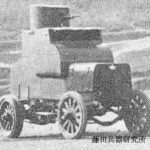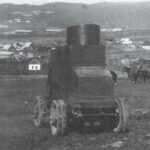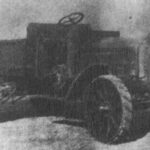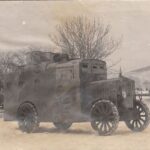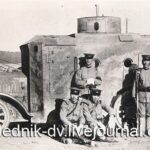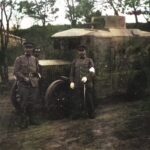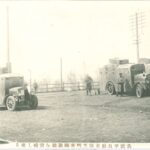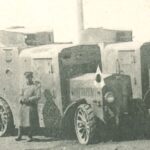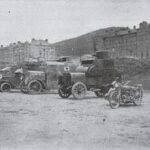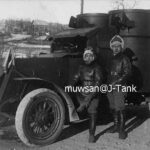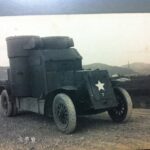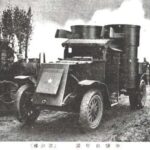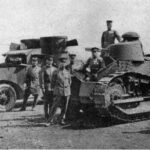All photos are from livejournal
With the kind correction of Mr Akira Takizawa (Taki)
We left the Empire of the Rising Sun in WWI with a fledgling automobile industry, made up of one-off and disorganized attempts, an agreement with a British firm (Wolseley) and the start of production of typical TGE trucks type A. Japan’s participation in the First World War (where it was the ally of France and Great Britain) consisted essentially in blocking the large German naval base of Tsingtao, and in occupying the German possessions in the Pacific, c ie the Mariana Islands, Carolinas and Marshall Islands, which was done as early as 1914.
The Russian revolution of October 1917, then the Treaty of Brest-Litovsk between Germany and Russia signed on March 3, 1918 had an important influence on the Japanese position in Asia. Indeed, considerable stocks of Allied material were then stored in Vladivostok. These stocks arriving from the United States and Canada and intended to support the Russian army in its fight against Germany became with the Russian defection and the civil war which followed a tempting prey for all the actors of the region. In order to secure these stocks, the triple agreement sent (reduced) contingents and naturally appealed to the allied country which could provide the most troops quickly, ie Japan. This was the intervention of Eastern Siberia between 1918 and 1922 which saw Western and Japanese attempts to help the White Russians (Admiral Kolchak) against the Bolsheviks. Japan of course also had its own goal: to extend its area of influence in the region (following an agreement between the parties, the Japanese troops had to reach 8,000 men, they were 70,000 in August 1918, which demonstrated Japan’s ambition in the region). In 1922, all these attempts were a failure and the contingents re-embarked one after the other after the defeats of the white armies. Note that in this adventure against the Bolsheviks, Vladivostok also saw two legendary formations, the Czech legion and the Belgian auto-cannon expeditionary force.
The first armored cars:
The first use of Japanese armored cars took place during Japan’s intervention in eastern Siberia from 1918 to 1922. On this occasion, a detachment of armored cars was formed. This detachment included: an armored car captured on the Russians (Vladivostok armored car or Fiat omsk, the model with turret), some Austin (one can see as much as four on the photographs) And three experimental (japanese name) armored cars made in Japan.
The Fiat Omsk:
The Fiat Omsk was captured during the attempt to take the city of Vladivostok by Japanese troops on the night of April 4 to 5, 1920, rearmed and bearing a star on the front. It was subsequently transferred to Korea, still part of the IJA. See also here
The Japanese experimental armored cars:
The Japanese experimental armored cars (two different bodies) were built at the Osaka arsenal (which is why they are also sometimes called wrongly Osaka armored cars), sometimes also called « Shisei Soko Jidosha » (literally: experimental armored cars) on two different truck chassis.
The light model (or medium for Japanese) on a modified chassis of the « San-ton » (three tons) prototype truckwith five crew members, two copies requisitioned by the army, including one sent to Siberia.
The medium model (or heavy for Japanese) on the chassis of the 4t Army type truck with seven crew members, two copies requisitioned by the army, both sent to Siberia.
We can see a maximum of three in the photos, one light and two medium. We don’t know their history or what has become of them. It is possible that, as for the fiat Omsk, they were sent to Korea at the end of the japanese intervention in Siberia.
The Austin armored cars:
For the Austin, we know that Japan bought six Austin (4th series according to Russian terminology and model 1918 according to English terminology) from England in 1919 (previously used by the 17 btl of the Royal Tank Corps), these austins were tested in Juky 1919 and four of which were sent in Siberia but also that it is possible that the Japanese troops seized Russian models during the combats (which would explain why we see camouflaged copies alongside plain green copies). So it is not clear how many Austin Japanese troops owned in Siberia. These armored cars were then used in Manchuria under the Nibangawa armored cars corps until the incident of Jinan (against the Chinese warlords of the north) in 1928, they will then be withdrawn from active service. In 1932, the three remaining vehicles due to lack of spare parts and because of the wear of the material were sent back to Japan, the body was deposited and after modifications placed on a Chiyoda type Q 3-axle chassis. The new name was Chiyoda Austin. These machines were sent to Manchuria. In fact, after the Manchurian incident of december 1932, there was a shortage of armored vehicles, a request was made by the Kwantung Army chief of staff for Wolseley armored cars, but there were only two available in Japan, so the Ministry of War Weapons Bureau decided to quickly modify existing Austins . The following year one of them was sent to Tianjin to support the Japanese forces. One of them was modified and adapted on a new chassis (Chiyoda type Q) with tires and new turrets (of the tankette type 94), it was still in service in 1937.

